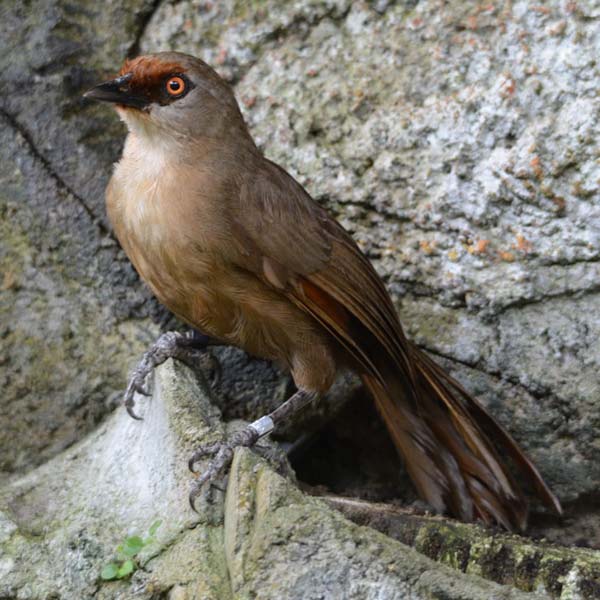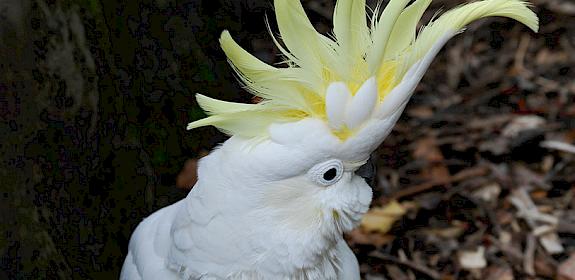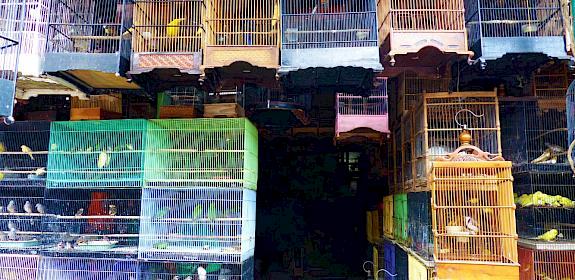IUCN Red List update highlights trade threat to Southeast Asian birds
Petaling Jaya, Malaysia, 8th December 2016—First profiled through TRAFFIC’s work on birds threatened by demand for the cagebird trade, a number of Southeast Asian birds are now perched in higher categories of threat in the latest update of the IUCN Red List released today.
According to the IUCN, the Rufous-fronted Laughingthrush Garrulax rufifrons (Critically Endangered), Scarlet-breasted Lorikeet Trichoglossus forsteni (Vulnerable) and Straw-headed Bulbul Pycnonotus zeylanicus (Endangered) are among a suite of species uplisted to higher threat categories as a result of the impacts of trade. Ample evidence points towards unsustainable levels of illegal capture for the cagebird trade, largely centred on Java, as driving their deteriorating status.

The list of species identified for uplisting was drawn from the 28 species prioritized during the first Asian Songbird Trade Crisis Summitheld in September 2015. The Summit brought together experts from various fields to formulate actions to save them from extinction. An IUCN-SSC Southeast Asian Traded Songbird Specialist Group was conceived during the Summit and is in the process of being created.
Prior to the summit, TRAFFIC sounded the alarm in a report recording over 19,000 birds representing 206 species for sale in Jakarta’s Pramuka, Jatinegara and Barito markets over a three-day period. Another three-day inventory of five major markets in eastern and central Java documented nearly 23,000 birds for sale. This May, another paper highlighted 13 bird species and a further 14 subspecies found in Sundaic Indonesia that are at serious risk of extinction because of excessive over-harvesting. It was through these studies, and the Summit, that species previously thought to be abundant and relatively unaffected by trade were brought into the spotlight.
The Greater Green Leafbird Chloropsis sonnerati is one such example. It was only traded in low volumes a decade ago, but in the past few years work by TRAFFIC and other organizations including Planet Indonesia has uncovered a massive demand for the species, exemplified by confiscations of thousands of individuals. It has been uplisted to Vulnerable.
TRAFFIC submitted data from these market surveys and trade analyses through the BirdLife Threatened Bird Forums and a recent publication on laughingthrushes to support the recommended uplistings of many of these species. Of the 407 bird species regarded as threatened with extinction in Asia, hunting and trapping is considered a threat to 226 (56%) of them within the revised Red List.
It is important that the conservation status of these species are being updated to reflect the threats facing them, but much more needs to be done to address this looming Asian songbird crisis. It is due to lack of research, lack of protection measures and ineffective regulation that these species have been ranked in this list of threatened species in the first place.
Chris R. Shepherd, Regional Director of TRAFFIC Southeast Asia.
The second Asian Songbird Trade Crisis Summit will take place in February 2017, gathering all partners to share progress since the first meeting and to put into action the regional strategy to enhance conservation and enforcement efforts for bird species threatened by trade.
In addition to a number of songbirds, the Grey Parrot Psittacus erithacus and Timneh Parrot Psittacus timneh were also uplisted. In October, both species, collectively termed African Grey Parrots, received higher protection under the Convention on International Trade in Endangered Species of Wild Fauna and Flora (CITES) through a listing in Appendix I due to unsustainable levels of harvesting for trade. A WCS and TRAFFIC study highlighted discrepancies in trade figures of the import and export of the species in Singapore.
About IUCN

The International Union for Conservation of Nature (IUCN) is a membership Union uniquely composed of both government and civil society organisations. It provides public, private and non-governmental organisations with the knowledge and tools that enable human progress, economic development and nature conservation to take place together. For more information visit: iucn.org





